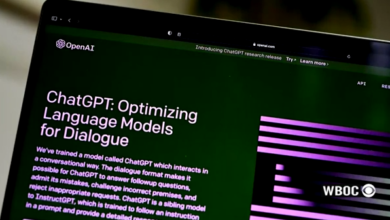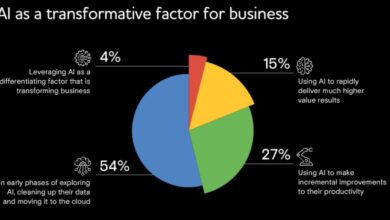Are Chatbots the New Face of Financial Customer Service?

Move over, human tellers: artificial intelligence (AI) chatbots may be the new face of banking. As digital solutions continue to disrupt the industry, experts say these conversational AI systems are poised to slash costs and streamline operations while keeping customers engaged and satisfied.
With their ability to handle high volumes of routine inquiries, AI chatbots are making significant strides in improving customer service efficiency. Bank of America’s virtual assistant, Erica, has dealt with over 50 million client requests since its launch in 2018, demonstrating the potential for chatbots to alleviate the workload of human agents.
“AI virtual assistants and chatbots allow consumers to complete simple banking tasks without needing to visit a physical location or call a customer service line, getting them the information they need quickly and efficiently,” Jorge Camargo, managing director of digital product management at Bank of America, told PYMNTS. “Over 98% of clients get the answers they need from Erica.”
Boosting Efficiency
The dual functionality of chatbots, serving both internal and customer-facing roles, allows financial institutions to streamline processes and improve overall efficiency. Ilya Smirnov, head of the AI/ML department at the software development company Usetech, told PYMNTS, “Internal chatbots can assist employees with tasks such as booking meeting rooms or scheduling appointments, while customer-facing chatbots provide initial assistance, answer typical questions, and offer advice.”
Nick Sanchez, senior solutions architect at Druid AI, told PYMNTS, “Nearly all organizations within FinTech have implemented automation, such as now-archaic IVR [interactive voice response] menus or on-site ‘click bots,’ to provide self-service options for external consumers. AI has also been used to improve the consumer experience in other ways, such as providing new methods of authentication via voice biometrics and identifying extra-dimensional call insights by referencing tones, devices being used, and more.”
Overcoming Hurdles and Regulatory Challenges
Despite the potential benefits, the widespread adoption of AI chatbots in financial services faces several obstacles. Data privacy, security and regulatory compliance remain critical concerns, as financial institutions must ensure that their AI chatbots adhere to strict data protection and privacy regulations, Adnan Masood, chief AI architect at UST, told PYMNTS.
Stephen Greer, a banking industry consultant at the software development firm SAS, highlights the regulatory concerns surrounding chatbot automation, telling PYMNTS, “Using AI to provide advice or offers opens up a whole can of worms around AI ethics. The Consumer Financial Protection Bureau [CFPB] has delved into the issue, raising concerns about data privacy and security risks, potential bias, information inaccuracies and more. That chatbots could lead to an overall erosion in consumer trust is a very real concern, particularly in financial services.”
Integrating AI tools into legacy platforms, building customer trust, handling complex cases, and navigating regulatory requirements pose significant challenges. Roman Eloshvili, founder of ComplyControl, told PYMNTS, “Regulatory bodies are generally opposed to the full automation of processes and require that all decision-making processes within AI systems be explainable. However, with current AI models, this is often not possible.”
Sanchez pointed out that the hesitancy in implementing AI technologies can be attributed to financial institutions’ slow adoption rate of new technologies.
“Through a combination of reliance on existing technologies, refusal to adapt in the now, and of course, the potential risk of repercussion should a bad decision be made, institutions have stunted themselves from considering viable alternatives that can improve, not just the experience of the user, but the organization as a whole.”
Road Ahead for Chatbots in Finance
As AI technology advances, the future of AI chatbots in financial services looks promising, albeit with challenges to overcome. The next generation of chatbots is expected to leverage large language models (LLMs) and multimodal AI to offer proactive financial advice, instant loan decisions, and highly personalized services based on real-time data analysis.
At Bank of America, the focus is on continuous improvement and expansion of Erica’s capabilities. Camargo explained, “At Bank of America, we are continuously evaluating client feedback and behavior to grow the number of requests Erica can understand and develop new insights that Erica can provide to clients, further helping them manage their finances.
“In the background, we continuously monitor and tune Erica to help it evolve and continue to better serve our clients. Since launch, our team has made more than 50,000 tuning updates to Erica’s performance — adjusting, expanding and fine-tuning natural language understanding capabilities, ensuring clients are getting the timely and relevant answers and insights they need.”
Greer cautioned that deploying LLMs in consumer-facing applications may be challenging. “It’s not clear that these LLMs will be fit for B2C deployment any time soon. And notably, SAS’ recent GenAI market study revealed that only 10% of business leaders feel prepared to meet the regulatory compliance mandates that will govern their use.”
Integrating complex algorithms and optical character recognition technology could enable chatbots to work with documents and photos, allowing customers to submit documents directly through the chatbot interface.
Smirnov envisioned, “It is also possible to help the client in formulating requests: when typing, pop-up prompts with possible formulations of the question or problem may appear.”
Sanchez predicted that banks and financial institutions will quietly convert into cryptocurrency exchanges, relying on their public image and consumer trust to compete against crypto-first exchanges.
“Just like the release of ChatGPT, there will eventually be a major shift in utilizing cryptocurrency in everyday life, and the end user, who is used to tapping to pay already, will never know or experience a difference.”
As chatbots handle an increasing number of routine tasks, the role of human employees in banks is likely to shift toward moderating and controlling AI systems. Eloshvili said, “We can also expect a reduced need for low-level staff in banks, such as account managers and tellers. Automation and AI tools will increasingly take over routine tasks like onboarding processes, customer support and everyday banking services.”
The evolution of AI chatbots has the potential to reshape the financial services landscape, offering personalized, efficient and accessible support to customers worldwide. However, Greer concludes, “Long term, there is a ton of potential. AI will revolutionize how consumers work and interact with their financial institutions, but the industry must see this evolution as a marathon, not a sprint.”
Financial institutions that successfully navigate this new landscape, striking the right balance between technological innovation and human interaction will be well-positioned for success in the digital age. The journey toward fully integrated AI chatbots in financial services may be complex, but experts say the potential benefits for customers and institutions make it a path worth pursuing.
For all PYMNTS AI coverage, subscribe to the daily AI Newsletter.



